|
1.
CENTRAL/ WEST AFRICA
Logs the main interest
Reports from exporters in W. Africa indicate that business
with Asian and Indian buyers continues to be brisk. Logs
are the main interest in these two markets. The recent
increase in enquiries for sawnwood for the Asian markets
seen earlier in the year have not translated into firm orders.
Prices holding firm
The European interest in W. African wood products
remains very subdued. However, price increases for
specific species and sizes of both log and lumber secured
by exporters in March are now firmly established.
Analysts say it will require a sustained upward movement
in demand before prices move any higher.
Alternative log source steady market
The fear of a destabilisation of the log trade as a result of
the decision by Gabon to ban log exports has subsided,
helped by the higher volumes being made available by
Cameroon following the relaxation of restrictions on log
exports.
Exporters in Congo Brazzaville have also been hard
pressed by Asian buyers to maximise log export volumes
to make up for the shortfall from Gabon.
Gabon rushes to meet deadline
Efforts in Gabon to transport and ship all logs cut before
the January log ban announcement are running into
difficulties. It is taking longer than expected to haul and
transport the logs to the port and there are reported
difficulties in handling and loading the logs onto available
vessels. The original cut-off date to ship logs felled up to
the date of the export ban has passed.
Traders now feel that shipping all the logs might well
stretch to the end of April but there has been no official
statement on a change of deadline. The logs now being
shipped are at least 4 months old, past their best condition
by normal trade standards. Buyers prefer fresh logs hence,
the pressure is growing on Cameroon and Congo to step
up log exports.
Second quarter prospects
For the second quarter 2010 it seems likely that European
buyers will concentrate on a very small number of
sawnwood species, including sapele and sipo, padouk,
iroko, azobe and a few other premium timbers. Prices for
these timbers should remain firm, say analysts.
The economies of Asian importing countries have
strengthened. Demand for logs from West and Central
Africa is particularly strong in India and exporters feel that
prices will be stable with the prospect of some further
increases.
There are no price changes to report after the increases
recorded in March.
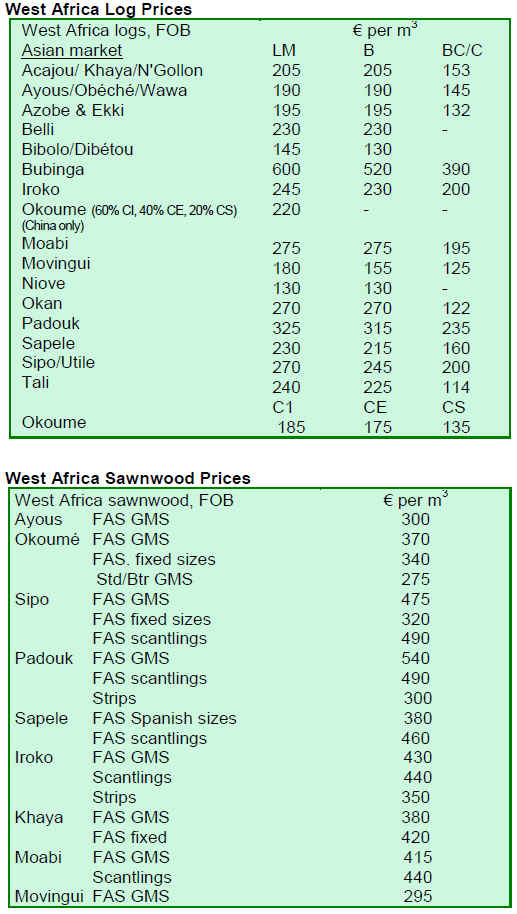
2. GHANA
Ghana¡¯s top ten sawnwood timbers
Export data for 2009 highlights the slow pace of market
growth for kiln dried sawnwood from Ghana. Of the
almost 1 mil. cubic metres of sawnwood exported, only
around 6% was kiln dried, the bulk being air dried.
As will be seen from the following graphics there is a
marked difference in the range of species exported
depending on whether the timber is kiln or air dried.
Wawa dominated exports of kiln dried sawnwood in 2009
but for air dried sawnwood Emire, Ceiba and Odum
accounted for over two thirds of totaled exports.
Exports of air dried Wawa were negligible as this timber is
highly susceptible to insect and fungal attack if not kiln
dried.
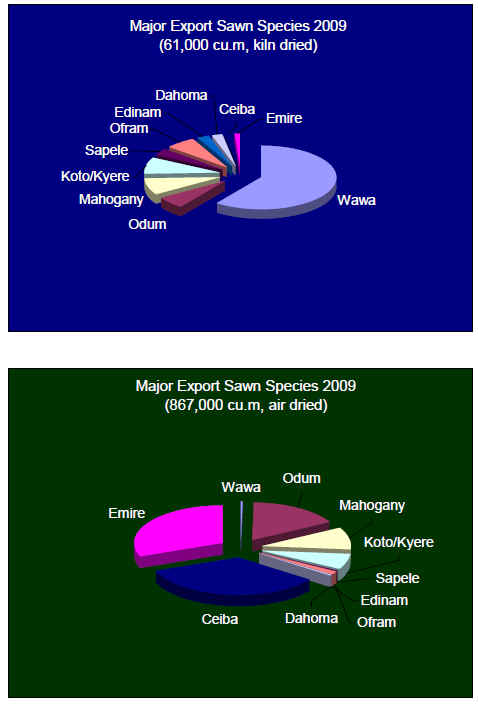
Special permit exports
During the period under review, six special export permits
were issued solely for Takoradi shipments including 67
cubic metres of Okoum¨¦ kiln dried laminated mouldings,
31 cubic metres of Odum kiln dried decking strips and 90
cubic metres of sliced veneer of various species.
These products were shipped by Machined Wood Ltd and
Africa and Auson Veneer (Ghana) Ltd to their clients in
Italy and France.
The laminated mouldings were manufactured from
Okoum¨¦ sawn timber imported from Gabon while the
sliced veneers were imported from Cameroon for reexport.
Upon application, the Ghana Timber Industry
Development Division (TIDD) grants special permits to
millers who intend to ship smaller quantities of some
selected wood products to their clients as samples for
testing.
While such items are not considered to have any
commercial value it is mandatory for the exporters to
secure these free/special permits before shipping.
Minor wood products
Export duty free permits were also issued for the
shipments of timber stumps, wood handicrafts and wood
carvings during the last quarter of 2009. These shipments
were also made through the port of Takoradi.
The shippers were John Bitar Ltd and Peewood Craft and
Art to buyers in the United Kingdom, the United States
and Spain.
Company Registration
A total of eighty company registration applications were
processed during the fourth quarter period of 2009 as
compared to ninety-one for the previous quarter,
representing a decrease of 12.09%.
Out of the total applications processed, fifty-one were
Exporters (45 Export Trading Companies and 6
Saw/Ply/Processing Mills). A further 29 non-Exporters
comprised the following; retailers (1), dealers in wood
products (14), boat manufacturers (8), dealers in wood fuel
(3) and 3 others.
Seeking Partnerships
At present, Ghana's industrial base suffers from inadequate
financial and technical resources. Working with Ghana's
Investment Promotion Centre and other institutions, the
TIDD seeks to create technical and investment
collaboration between Ghanaian timber processing
companies and their opposite numbers in overseas
markets.
Partnerships offer the potential to enhance incomes and
abilities of local companies and their workers, and at the
same time offer cost savings to foreign investors.
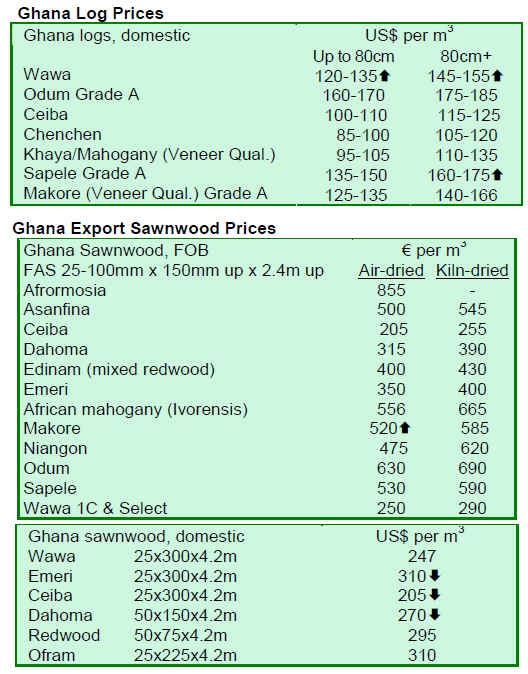
3.
MALAYSIA
Steel price affects plywood demand
Plywood prices have been moving up over the past month
and a number of factors have contributed to this change.
The main factor driving up plywood prices is said to be the
recent jump in demand (and hence price) of iron ore in
China. This has resulted in rising steel prices in most
markets. Plywood and steel products compete in many
enduses and plywood has suddenly become more
competitive. Analysts are expecting these factors to affect
price structures in other sectors of the timber industry.
Reportedly, iron ore prices tracked through a benchmark
system used by major Japanese, Korean and European
manufacturers, almost doubled in 2009.
The benchmark price of iron ore in 2009 was US$70 per
ton (Australian powder ore), inclusive of transportation.
However, the recent spot market prices for iron ore from
India destined for China have jumped to around US$140
per ton. Similarly, in Japan, Nippon Steel has reportedly
agreed a price of US$110 per ton for April to June
deliveries.
The increase in steel prices is expected to impact the price
levels of other construction products. Plywood traders are
saying that construction plywood prices could increase by
as much as 20% over the next few months and that
eventually this will lift the prices of other wood products.
In addition, news that plywood stocks in Japan have been
run down and are now being replenished is encouraging
the plywood producers in Malaysia and Indonesia.
The STA view
The Sarawak Timber Association (STA) has indicated that
plywood stocks in Japan have been declining for the past
12 months in the face of the sharp drop in housing starts
and cuts in civil construction projects.
Most plywood mills in Malaysia and Indonesia reduced
output due to the poor demand in international markets
over the past year and a half and are likely to maintain low
production until they see improved price levels take a firm
hold.
Sarawak exports
Exports of wood products from Sarawak continued to
decline in the first two months of 2010, dropping by over a
third compared to the same period in 2009.
In addition to weak overseas demand, part of the decline
was due to log transport problems caused by a dry spell as
water levels in many rivers were too low for transporting
logs to the mills.

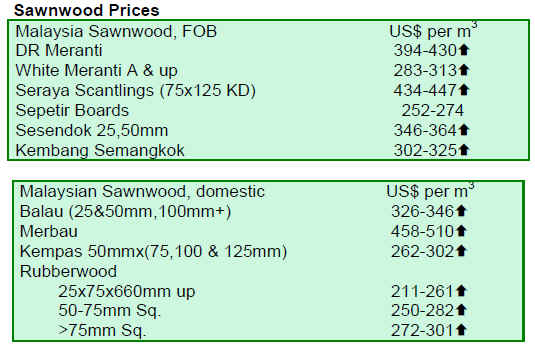
4.
INDONESIA
Export growth forecast
According to Indonesian Government analysts, the
country¡¯s non-oil and gas exports, which include wood
products, are likely to increase this year.
The rise in exports is said to be driven mainly by
expanding demand in China and other Asian economies,
notably South Korea.
Non-oil and gas exports in the first two months of 2010
were just over US$18 billion and estimates of March
exports are in the region of US$8-9 billion. Non-oil and
gas exports to China stood at US$2 billion for the first two
months of 2010, an increase of over 130% compared to the
same period in 2009. Similarly, exports to South Korea
more than doubled.
Mono-cable logging
The Indonesian timber industry is testing a logging system
which is not commonly used in tropical logging
operations.
The so-called ¡°mono-cable¡± system has been promoted as
an ¡°environmentally friendly¡± alternative to the traditional
crawler tractors. The mono-cable system is said to cause
less damage to the remaining standing trees and less soil
disturbance than the heavy tractors commonly used to
harvest tropical logs.

5.
MYANMAR
MTE relocates
Visitors to the Myanmar Timber Enterprise (MTE) head
office have found that the long awaited relocation of the
office is underway. MTE has occupied its current office
for 55 years and a move just before the Myanmar New
Year Holidays (10th April till 21st April) came as a
surprise to many in the trade.
The MTE office will apparently be in Gyogon, Yangon, at
the former office of the Director-General of the Forest
Department. The Forestry Department moved to the new
administrative capital, Naypyitaw, some time ago. As teak
timber is a specialised item and is of interest to just a
handful of dedicated buyers, the relocation will quickly
become common knowledge.
The old MTE riverside office with log storage ponds and
the vast log yard will remain a fond memory of many old
timers who remember State Timber Board (precursor to
the present MTE) moving its office from downtown
Yangon to the Forest Compound in Ahlone Road.
It is reported that MTE will hold its April tender sales at
its previous office in Ahlone; and the May tender will be
held at the new location.
New Year holidays bring business to a halt
The month of April is the beginning of the new fiscal year
2010-11. The 1st of April usually starts with the annual
stock taking at state owned saw mills and log yards and
lasts for about a fortnight.
This year, the month of April has altogether 17 days of
holidays. These 17 days, plus the annual stocktaking
period, will bring the timber business to a halt until month
end.
The MTE is actually the hub upon which the whole timber
business in Myanmar revolves and because of the
relocation of the MTE office coupled with the New Year
holidays, business is likely to grind to a halt.
Hardwood shipments increase
The following table shows the hardwood shipments made
by the MTE in the financial years of 2008 and 2009.
It will be seen that for FY 2009 shipments (excluding the
border trade) were almost 890.000 tons, almost 200,000
tons above shipments in FY 2008.
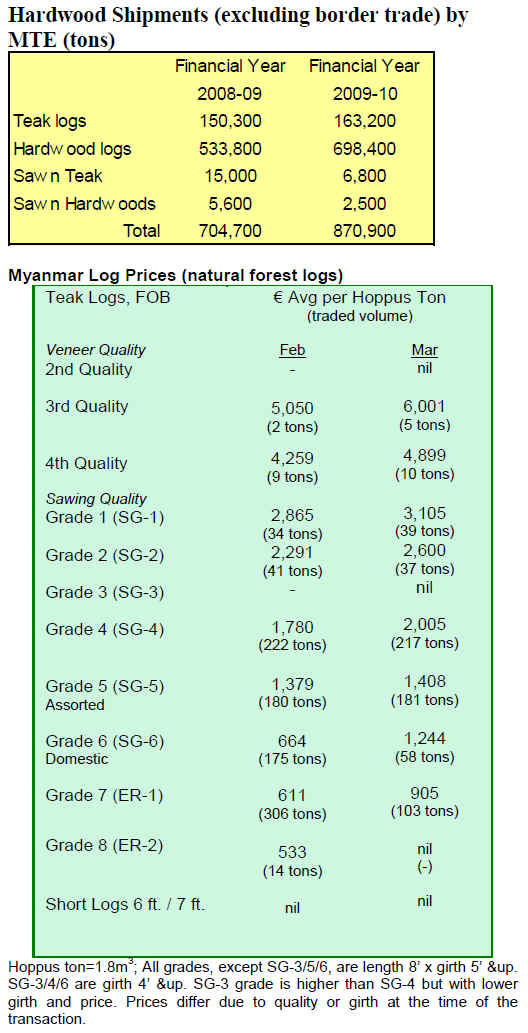
6. INDIA
Hardwood auctions
Auctions of Teak and other hardwoods continue to attract
active buying. The volumes offered at auctions in Central
Indian and in the log depots in Gujarat are satisfactory.
Sales are swift and prices are tending to remain firm.
Further auctions will be held in late April at various log
depots in the north and south Dangs division. During the
April auctions some 7-8,000 cubic metres of hardwoods
are expected to be put up for sale, out of which Teak is
approximately 70%. The other hardwood species to be
sold include timbers such as Laurel, Haldu, Bija and other
local hardwood species.
Economic progress continues
In line with WTO forecasts of improving global trade,
exports from India rose 35 per cent in February to just
over USD16 billion, the fourth consecutive rise after 13
months of decline. Similarly, February imports also rose,
climbing 66% (US$25 billion) compared to February last
year. Industrial output also rose by about 16% year on
year.
The rapidly growing economy has attracted considerable
foreign investments and this, along with other positive
economic fundamentals, has taken Indian Rupee to a 19
month high against US dollar. At one point the exchange
rate touched Rs.44.44 to a US dollar.
Woodworking training boosts production
The Advanced Woodworking Training Center (AWTC)
has been established in India and reports indicate that the
benefits from improved training opportunities are being
already being felt in the industry.
The AWTC is a joint venture between the Indian and
Italian Governments and ACIMALL (Italian
Woodworking Machine and Tool Manufacturers
Association).
Indiawood 2010
Details of the recently concluded Indiawood 2010 held in
March this year are just emerging. Indiawood is a biannual
event organised by PDA Trade Fairs and Eumabois.
The objective of Indiawood is to present to the Indian
market the latest in wood processing technologies and
tools, accessories and fittings and other consumables from
around the world.
This year a special focus was on wood and bamboo in
architecture which addressed both management and
processing of bamboo in construction and for energy
generation using bamboo residues.
The event was a sourcing ground for the entire
woodworking community from India, South Asia, South-
East Asia and the Gulf region.
Indiawood 2010 attracted over 24,000 visitors to view the
more than 450 exhibitors from 24 countries. The largest
representation was from Europe with a significant
presence from German, Italian, Canadian and US suppliers
and manufacturers.
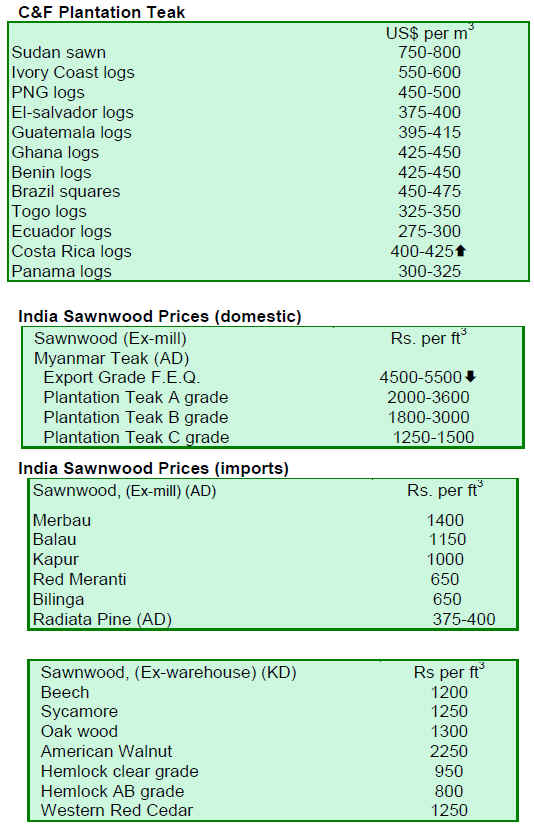
7. BRAZIL
Utilization of Paric¨¢
Research conducted at the University of Santa Catarina
has highlighted the potential of Paric¨¢ (Schizolobium
amazonicum); a lesser used timber, especially for glue
laminated products.
Paric¨¢ has been traded in small quantities as the timber is
found in the natural forest. However, timber from
plantation grown Paric¨¢ has different properties to that
from trees harvested in the natural forest.
Further studies on Paric¨¢ from plantations are needed to
determine the properties of timber from trees harvested at
various ages.
It is anticipated that Paric¨¢ from plantation forests could
be used to produce laminated products suitable for
building and construction uses.
Forest Service Timber Price Index
The Brazilian Forest Service (SFB) has recently started to
compile a tropical timber price index. The index in
January was 1.091, compared to the October 2009 baseline
(index = 1.0), the first month when prices were surveyed.
The change in the price index has come about, it is said,
mainly due to price increases for the low and mediumvalue
timber species which were actively traded in the
period reviewed.
The SFB says that business transacted in the Bel¨¦m-
Bras¨ªlia and Cujubim timber markets contributed most to
the improved price index. The reported short supply of
some timbers, due to slow harvesting in the rain season,
was also a factor for the change in the price index.
The IPMA Index calculation involves three steps. First, a
survey of processing plants in various areas is undertaken.
Some 20 to 25% of the companies in the various
production clusters in the region are surveyed (approx.
1,000 mills). The second step is to assess the harvest
volume and timber transport approvals (Forest Origin
Document and Forest Products Trade and Transportation
Documents).
The final step in compiling information for the index is a
survey of prices that sawmills, plywood, and laminated
and sliced veneer mills pay for delivered logs. The index is
published on the SFB website (www.florestal.gov.br).
Domestic trade at new highs
Wood product sales in Mato Grosso have been growing
steadily over the past years. From 2006 to 2009 the
market was worth just over R$ 6.3 billion and has
continued to expand. Over the same period wood products
valued at over R$ 4 billion were traded with other states or
within the region.
According to the State Secretary of Environment (SEMA),
exports from 2006 to 2009 were in the region of R$1.4
billion.
Of all the production forest clusters in Mato Grosso, the
Sinop cluster traded the most with a 15% share of the total
trade. Sinop was followed by Aripuanã (9%), Ju¨ªna (7%)
and Alta Floresta (5%).
According to SEMA, Sinop traded a total of R$ 933.4
million over the four year period. Of this trade over 70%
was destined for the domestic market, while the balance
(some R$ 261 million) was exported.
Aripuanã traded around R$ 569 million, over R$ 340
million for the local market and the balance for export.
Juina traded R$ 444.8 million in nearly four years. In
contrast to the trade in Sinop and Aripuanã the bulk of the
trade in Juina was to international markets (R$ 227.2
million). Slightly less than half of the trade was in
domestic markets.
Trade incentive needed in Southern Brazil
Forest sector analysts consider that the wood product
manufacturing sector in the state of Paran¨¢ is
underperforming and that certain sectors of the industry
would benefit from government trade incentives.
Trade statistics are indicating that output in the timber and
pulp and paper sectors is gradually recovering from the
effects of the global financial crisis. But, as pointed out by
the Paran¨¢ Industry Federation (FIEP), not all industry
sectors are recovering at the same pace.
As a result of the collapse in global markets, the solid
wood industries have suffered steep declines in sales
(down 11% in 2009). However, in contrast, the pulp and
paper sector in the region recorded a 5% growth of sales
last year.
The solid wood timber sector relies heavily on demand in
the North American housing market, a sector which
accounted for almost half of the export from the State.
Prior to the crisis, the timber industry exported a quarter of
its production; the paper industry exports only 16% of its
output and is less vulnerable to the ups and downs of the
international market.
Despite the gloomy picture, there are signs of recovery in
the manufacturing sector and more companies have moved
into the Telemaco Borba Industrial District.
According to the Jaguaria¨ªva Timber Industry Association,
the government should consider ways to assist the industry
to climb out of the difficult situation it is facing.

8.
PERU
Export recovery
Further signs of economic recovery in Peru came recently
when February export data were released by the Ministry
of Foreign Trade and Tourism.
Exports in February totalled US$2.6 billion, a 40 percent
increase over the same month in 2009. This improvement
was due mainly to increased international demand for
commodity products.
Crude oil exports were up 750 percent, agriculture product
exports were up 240 percent, zinc exports improved by
185 percent and copper oil derivatives were up around 100
percent. These products accounted for around US$2.4
billion of the total exports of US$2.6 billion.
The so-called non-traditional exports (mainly
metallurgical products, crafts, and minerals) grew by
almost 20 percent.
Exports to N. America were up by almost a third and
exports to the EU increased by about 50 percent. German
and Italian imports from Peru more than doubled in
February and this lifted the overall EU import figures.
Asia remains a major export market and there were
significant increases in exports particularly to Japan and S.
Korea.
Diversifying exports
One outcome of the slowdown in Peru¡¯s exports of wood
products, a result of the recent financial crisis, was a
diversification of markets. As companies sought to sustain
sales, new markets were sought.
In 2009, in the face of diminished demand in the
traditional markets of the US and Mexico, interest from
buyers in other countries was actively pursued with
success seen with New Zealand, where exports jumped
threefold.
Recently, there has been some interest from buyers in
Australia, particularly for certified wood products.
Historically, the trade between Australia and Latin
American countries has been small, especially when
compared to trade with Australia¡¯s Asian neighbours.
However, there are signs that markets for wood products,
especially certified products, from Peru can be developed
in Australia.

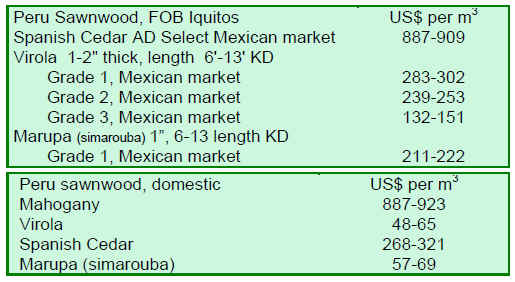
9.
Guyana
Market news
For the period under review, log prices remained stable.
Earnings were derived primarily from exports to Asia -
Pacific markets.
Prices for rough sawn (undressed) Select Greenheart were
very favourable, reaching as high as US$1,140 per cubic
metre. In contrast, prices for sawn Purpleheart (Select)
declined slightly but sawn Mora prices remained
unchanged.
Dressed Greenheart prices for this fortnight period moved
up to US$1,414, a record high thus far for the year. In line
with the prices for rough sawn timber, dressed Purpleheart
prices also dropped.
Guyana¡¯s Washiba (Ipe) continues to be in demand and is
attracting price levels of US$1,200 for rough sawn lumber
and US$1,500 for dressed lumber.
Baromalli plywood prices have now moved up slightly on
the levels seen recently. Prices for both BB/CC and Utility
qualities have increased.
Splitwood prices moved positively to attain levels of
US$1,387 per cubic metre in the period under review.
Added value exports
Outdoor garden furniture, doors, windows and non timber
forest products continue to be in demand in the Caribbean
island markets and exports of these added value products
helped improve export earnings.
Community chainsaw milling
Chainsaw milling by forest communities is common but
often carried out inefficiently. To assist a local community
in Guyana, a project involving the Guyana Forestry
Training Centre and Iwokrama, with support from
Tropenbos in the Netherlands, is being undertaken. The
objective is to educate chainsaw operators and millers on
the best practices in harvesting forest products and more
efficient log utilisation.
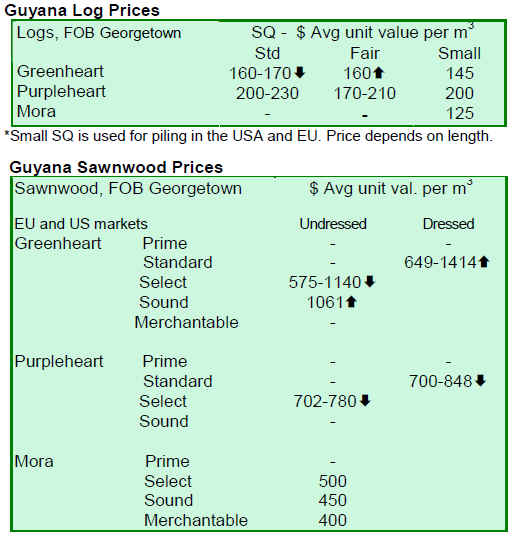
|